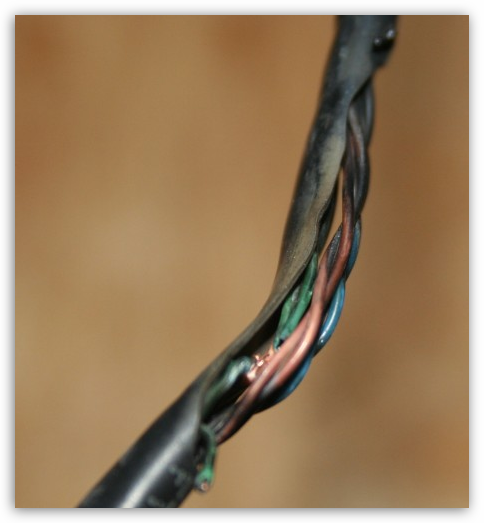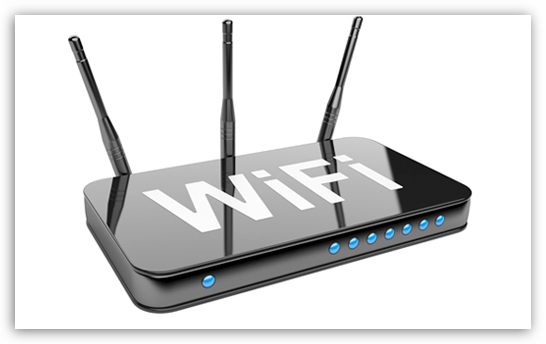The Internet lags. Educational program: why the Internet via Wi-Fi slows down at home
- Recovery Mode
The classic scheme for turning on Internet services in an apartment building is as follows: TKD (collective access point) - twisted pair - a router in the client's apartment, to which client devices are connected via wire and Wi-Fi.
Typical complaints from subscribers - the speed is lower than the tariff, and regular "freezing" occurs when working on the Internet, which is expressed by long opening pages in the browser, video interruptions, loss of connection with game servers, etc. This behavior is irregular, and most often occurs during the hours of the highest user activity from about 18:00 to 23:00, depending on the city.
There are a few simple steps which will determine possible reason similar problems and solve 90% of user situations. They are below.
The logical first step is to test your speed.
To fulfill this point, you should minimize the number of transit devices through which the Internet is connected in the apartment. Ideally, you should connect the operator's cable directly to the computer and configure the connection on it. After that, check the speed on resources that provide a similar service, for example, speedtest.net. This is a special service capable of transmitting data at high speed - which, alas, cannot be said about all resources on the Internet.
If you managed to reach a speed close to the one specified in the tariff, then there are no problems with the operator's equipment and the cable to the apartment. If the speed is significantly lower, the connection is constantly disconnected, you should contact technical support provider for diagnostics by the operator and, possibly, repair.
Please note that all “home” contracts always have “up to 10 Mbps” wording, where the most important part is “before”. Without this pretext, only corporate agreements are possible, where the bandwidth is guaranteed: you pay about 2-3 times more for this guarantee. But, nevertheless, the difference is more than 5-7% with the rate of the tariff, which is repeated with a direct connection at different times of the day - this is the problem of the provider.
The second step is diagnosing the router
Suppose you got normal speed "directly". Now you need to look at the intermediate devices. There are fairly old models of routers that are still used by users. These models have significant performance limitations that do not allow them to implement tunnel connections (L2TP / PPTP) at speeds above 20-30 Mbps. Examples of such routers are DIR-300, ASUS WL-520 and others. Unfortunately, only replacing the router with a more productive one, or using a tunnel-free solution, if your telecom operator has one, will help to solve the problem with speed in this situation.
By the way, we are going to switch to IPoE instead of L2TP soon.
- On DHCP, minimize the network of users from 255 hosts to the minimum number of devices + 3-5 guests using a network mask / 27 - 32 hosts, / 28 - 16 hosts, / 29 - 8 hosts. I recommend choosing / 28, because you are unlikely to have more than 16 devices on your home network.
- Select the router address not at the beginning and not at the end of the network, for example, for the 192.168.0.0/28 (255.255.255.240) network, set the router address to 192.168.0.8. The recommended network is 192.168.10.32/28 (255.255.255.240), the router address is 192.168.10.40. Glue on the router new address router.
- For home devices, map MAC + IP bindings in the DHCP pool so that the devices are tightly bound. Configure the restriction of access to Wi-Fi by the MAC addresses of your devices (but then guests at your home will not be able to connect or you will also have to register the MAC addresses of their wireless devices).
- Change the administrator password for accessing the router, use at least 8 characters as a password, taking into account the case change, as well as numbers and symbols. The administrator's login-password should be written down somewhere in a safe place right away; after such operations, we always have a lot of requests “how to reset the password”.
- Configure Wi-Fi: hide SSID, set WPA2 encryption, enter a password of more than 8 characters, case sensitive and numbers / letters.
Fourth step - channel selection
After the router has been configured, you need to pay attention to the used Wi-Fi channel on which the router and wireless clients are running. Many telecom operators, when connecting their clients, immediately issue a router in addition. Thus, almost every apartment with an Internet connection has a wireless Wi-Fi device.
Now the overwhelming majority of Wi-Fi equipment operates in a 2.4 GHz frequency; in total, there are 14 channels at this frequency on which wireless devices can work. In addition to frequency, significant parameters are signal-to-noise ratio, signal strength, and bandwidth. If all devices work on the same channel, then conflicts will arise between them, which for the user will look like regular "freezes", ie. fading when opening resources in a browser or interruptions in the broadcast of video and sound.
Therefore, it is necessary to select the channel on which least amount competitors with signal strength levels close to yours. Another option may be to "transfer" wireless devices to the 5 GHz range, but for this, the router and the wireless devices themselves must be technically capable.
Utilities that will help you analyze the channel occupancy are Wi-Fi Explorer for Mac, or inSSIDer for PC.

The screenshot of the WiFi Explorer program shows that the two networks Asus293 and r-r-r ... miau are close in signal strength to each other and a conflict may occur, but they are on different channels, the first network is on channel 11, the second on channel 12, which solves the problem.
Summary
Do not worry too much about the location of the router in the apartment relative to the windows or the effect of the microwave: it rarely causes any problems. It is recommended to place the router "in the middle" of the apartment with the priority of placement to the most frequent point of work with wireless devices, for example, in a living room or study, and not in a kitchen or in a closet in the hallway. From the point of view of device conflicts, in my experience there was only one case when a subscriber had radio noise in the 2.4 GHz band with a Samsung HW-H450 soundbar connected via Bluetooth, which acts as a music center. It was possible to reveal this only empirically.
The signal strength adjustment is not normally required. In multi-room apartments with concrete walls, it is sometimes important to study the radio broadcast with utilities like the ones listed above in order to make a decision about increasing the signal strength.
According to statistics, about 90% of requests were resolved in such simple ways.
Many of the inexperienced users are faced with such a problem as low Internet speed, and do not know what to do in this situation. In this article I would like to talk about the reasons and answer the question: "Why does the Internet slow down?"
The reasons can be different, from bad weather (if you have a 3G modem), to problems with the connection with the provider.
First, you need to make sure that the speed is low only for you, and not for all the customers of your Internet provider. Ask friends, family, or someone else. The main thing is that they have exactly the same Internet. Ask them if they are complaining about the speed and if it is very different from the one stated by the provider.
If everything is fine for the rest, and the Internet slows down only for you, then you need to look for the problem on your computer. Failures on the line connecting to the provider are also possible.
Solution of the question "why the Internet slows down": step 1
First you need to find out real speed... More precisely, what possible speed, and how much of that you can use. It will be necessary to scan traffic on the computer. For example, "NetWorx" or something else. There are plenty of such utilities.
After you install it, run it. Then you will need to right-click on the icon in the tray, and click the item "show graph". You will see a window with a graph of the speed change. Please note, not displayed maximum speed, and the one used in this moment.
And now you need to do the following. Do nothing and watch the changes on the monitor. That is, do not use a browser, some kind of correspondence programs, Skype, etc. Quit all programs that use the Internet.
If suddenly the graph shows that you are on the network, and some data is being downloaded to the computer, then, most likely, the Internet slows down a lot precisely because of this. You are not doing anything, and the internet is already in use. That is, you yourself, as a percentage, have less speed.
Solution of the question "why the Internet slows down": step 2
It is necessary to determine what exactly the world wide web is using at this moment. In general, this is quite easy to do if you have Nod 32 antivirus installed. If not, then look for some utility for this on the Internet.
If Nod, then right click on the tray icon and click show network connections.
You will see all programs that are connected to the Internet. Disable them. Close access to them. Most likely, these are some kind of viruses or "updaters" of some programs. For example, Adobe.
If there are viruses, then you need to scan your computer for their presence.
To configure Internet access for each program, you need to slightly tweak your firewall. Open the window with the antivirus and go to the settings, where we set the interactive filtering mode. Now, if some program wants to access the Internet, the antivirus will ask you whether it can be connected to it or not. Rules can be specified both for time and forever. If you saved forever, then at any time you can reconfigure.
Solution of the question "why the Internet slows down": step 3
If you do not have such problems, and access to world wide web use only you, then the problem is in something else.
If you have a 3G modem, then check the antenna level. Perhaps you have a bad connection and that is why the speed is very low. No need to plug in a modem from the back system unit and place it close to the wall. It is necessary to do so that the antenna can freely receive the signal. If this is not possible, then connect the device through an extension cord.
If not 3G, then try updating the drivers for network card... If that doesn't help, then check all cables. Due to wire breaks or oxidation, the data transmission quality can be significantly lower than it should be.
In other words, you need to look for problems in the connection between you and the provider or with the PBX.
Today, almost no apartment or private house is complete without home internet providing unlimited Internet access from all connected devices. Unfortunately, not every user can boast of high-speed and stable internet. Below we will talk about several simple tips, which will slightly improve the quality of the Internet.
Most likely, the tips given in the article will seem quite commonplace for many users. But in the event that it is not possible to increase the quality of the Internet by switching to a more expensive tariff or to another provider, then such recommendations may become the only way out of the situation.

Users who complain about low Internet speeds often do not take into account the number of running network programs per different computers(devices).
For example, if torrent clients are used on computers connected to the network, which are currently "downloading" files, then it should come as no surprise that sometimes even a web page in the browser cannot load normally. If possible, to check if software the reason for the slow internet speed, close all network programs on devices connected to the home network.
There is a large selection of programs available to monitor programs that consume internet traffic, such as NetLimiter. If necessary, in this program you can create a limit on the amount of traffic consumed by programs, although, as a rule, when it comes to programs with an increased appetite for traffic, they have built-in tools for limiting the speed.
If a problem with the brakes while surfing the web is observed, for example, on a computer, but everything works quite correctly on other devices, you should suspect viral activity, which in most cases affects the network.
First, check your computer for threats using the scan function of your anti-virus or, for example, using the free Dr.Web CureIt utility.
Additionally, you should check hosts file- and if changes are found in it, you will need to return it to its previous appearance. More details about this are described on the official Microsoft website.

Again, such a problem should only be observed in relation to a computer on which antivirus is installed, and not to all devices connected to the network in general.
Any antivirus includes various tools that allow you to check and protect different aspects operating system... In particular, antivirus can perform network scanning aimed at ensuring security while surfing the web, but as many users note, it is the antivirus that can lead to slowdowns on the Internet.
To check if your antivirus is the culprit for this situation, try to disable its operation for a while, and then check the Internet's functionality. If it really has improved, you should open the antivirus settings, in particular, you are interested in the network scanning functions, and disable the work of these tools.

Many users, for example, those who have independently made a home Internet connection, are faced with the problem of low Internet speed, which may arise due to cable damage.
If you know that the Internet cable has fractures, twists, kinks or other damage, you should definitely call a wizard from your provider who can test the bandwidth of your cable and, if necessary, replace it.

Often, users have been using old equipment for years, but at the same time they continue to be surprised that they own one of low speeds the Internet in the city.
First, check your current tariff and connection speed. For example, if in your case an ADSL connection is used, then you should not count on a speed higher than 11 Mbps.
If the speed of the Internet coincides (or is close) to the one declared by the provider in your tariff, then you should pay attention to the fresh tariffs: often the provider provides high-speed Internet at a much lower cost and includes the necessary equipment for free.
If in your case the Internet connection is carried out exclusively by wire, then this is not your case.
At the same time, if you suspect that your wireless network uninvited guests connect, especially when you have an obvious password for the wireless network or you do not have one at all, you should try to change the password from your Wi-Fi. If you do not know how this task is carried out for your router, try to execute search query with an indication of the model of your router - for sure instructions on how to correctly change the password from Wi-Fi are already available on the Internet.
Faced with a problem with the Internet, you should not take all the headache on yourself - this problem also applies to your provider. Having trouble understanding what caused the decrease in Internet speed and the appearance of brakes, you should not postpone the call to the provider.
 Architecture of a distributed control system based on a reconfigurable multi-pipeline computing environment L-Net "transparent" distributed file systems
Architecture of a distributed control system based on a reconfigurable multi-pipeline computing environment L-Net "transparent" distributed file systems Email sending page Fill relay_recipients file with addresses from Active Directory
Email sending page Fill relay_recipients file with addresses from Active Directory Missing language bar in Windows - what to do?
Missing language bar in Windows - what to do?